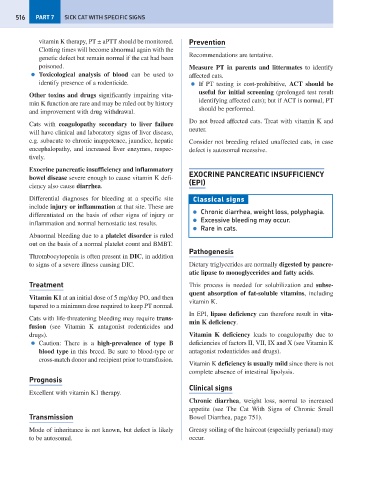Page 524 - Problem-Based Feline Medicine
P. 524
516 PART 7 SICK CAT WITH SPECIFIC SIGNS
vitamin K therapy, PT ± aPTT should be monitored. Prevention
Clotting times will become abnormal again with the
Recommendations are tentative.
genetic defect but remain normal if the cat had been
poisoned. Measure PT in parents and littermates to identify
● Toxicological analysis of blood can be used to affected cats.
identify presence of a rodenticide. ● If PT testing is cost-prohibitive, ACT should be
useful for initial screening (prolonged test result
Other toxins and drugs significantly impairing vita-
identifying affected cats); but if ACT is normal, PT
min K function are rare and may be ruled out by history
should be performed.
and improvement with drug withdrawal.
Do not breed affected cats. Treat with vitamin K and
Cats with coagulopathy secondary to liver failure
neuter.
will have clinical and laboratory signs of liver disease,
e.g. subacute to chronic inappetence, jaundice, hepatic Consider not breeding related unaffected cats, in case
encephalopathy, and increased liver enzymes, respec- defect is autosomal recessive.
tively.
Exocrine pancreatic insufficiency and inflammatory
EXOCRINE PANCREATIC INSUFFICIENCY
bowel disease severe enough to cause vitamin K defi-
(EPI)
ciency also cause diarrhea.
Differential diagnoses for bleeding at a specific site Classical signs
include injury or inflammation at that site. These are
● Chronic diarrhea, weight loss, polyphagia.
differentiated on the basis of other signs of injury or
● Excessive bleeding may occur.
inflammation and normal hemostatic test results.
● Rare in cats.
Abnormal bleeding due to a platelet disorder is ruled
out on the basis of a normal platelet count and BMBT.
Pathogenesis
Thrombocytopenia is often present in DIC, in addition
to signs of a severe illness causing DIC. Dietary triglycerides are normally digested by pancre-
atic lipase to monoglycerides and fatty acids.
Treatment This process is needed for solubilization and subse-
quent absorption of fat-soluble vitamins, including
Vitamin K1 at an initial dose of 5 mg/day PO, and then
vitamin K.
tapered to a minimum dose required to keep PT normal.
In EPI, lipase deficiency can therefore result in vita-
Cats with life-threatening bleeding may require trans-
min K deficiency.
fusion (see Vitamin K antagonist rodenticides and
drugs). Vitamin K deficiency leads to coagulopathy due to
● Caution: There is a high-prevalence of type B deficiencies of factors II, VII, IX and X (see Vitamin K
blood type in this breed. Be sure to blood-type or antagonist rodenticides and drugs).
cross-match donor and recipient prior to transfusion.
Vitamin K deficiency is usually mild since there is not
complete absence of intestinal lipolysis.
Prognosis
Clinical signs
Excellent with vitamin K1 therapy.
Chronic diarrhea, weight loss, normal to increased
appetite (see The Cat With Signs of Chronic Small
Transmission Bowel Diarrhea, page 751).
Mode of inheritance is not known, but defect is likely Greasy soiling of the haircoat (especially perianal) may
to be autosomal. occur.

